In this comprehensive post, we'll go over the following;
The safest way to Protect your home before a fire.
You'll also learn;
- Fire prevention tips,
- Safety info about smoke alarms,
- How to use a fire extinguisher, and
- What to do if there is a fire.
So if you've ever asked yourself any of these questions, you'll love this post!
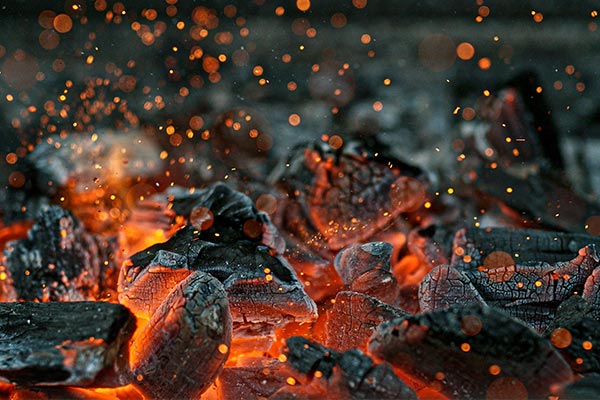
The National Fire Protection Association reports that an average of 361,500 home fires occur each year in the United States, resulting in $7.3 billion in property damage. This means a house fire occurs somewhere in the country every 89 seconds.
Our professional fire damage restoration team at Rock Emergency has compiled a list of common areas where a home fire occurs and ways to help protect your home before a fire.
Kitchen & Cooking
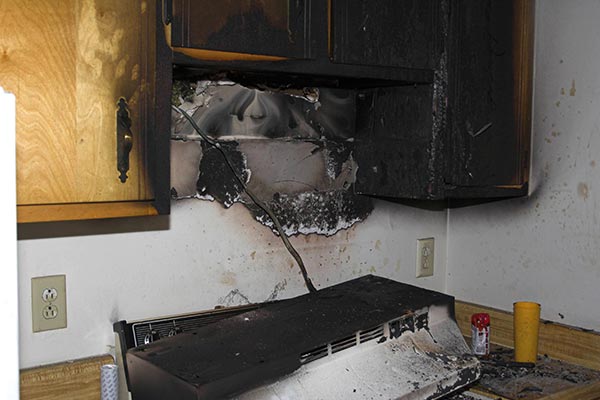
Cooking is the leading cause of residential fires, accounting for 49 percent of all fires between 2015 and 2019. Many of these fires are caused by people leaving cooking food unattended, having combustibles too close to the heat source, or forgetting to turn off cooking equipment when done.
As a result, Thanksgiving Day has more fires than any other day of the year, with the day before Thanksgiving and Christmas Day coming in a close second and third.
Follow the tips below to help prevent fires in the kitchen and while you're cooking!
- Never leave home while cooking on the stove or in the oven. Additionally, set timers to check on food regularly (if cook time is longer) and to ensure it is cooking correctly (liquid hasn't boiled away, not burning).
- Keep cooking appliances clean (stove, oven, toasters).
- Keep children and pets away from cooking sources. Not only can this prevent burns, but it can also keep flammable materials away from heat sources.
- While cooking, keep anything flammable away from the cooking elements. This includes oven mitts, towels, cookbooks, and utensils. Also, be sure clothing is tucked away, and long hair is tied back.
- Keep pot handles away from the edge of the stove. If they get bumped, they may cause spills or burns.
- When cooking with oil or grease, be especially careful. If the grease or oil starts a fire, smother the flame (using a pan lid, salt, or baking soda) or use a grease fire extinguisher. Using water will only spread the fire or cause severe burns.
Heating Sources (Fireplaces, Wood Stoves, Space Heaters)
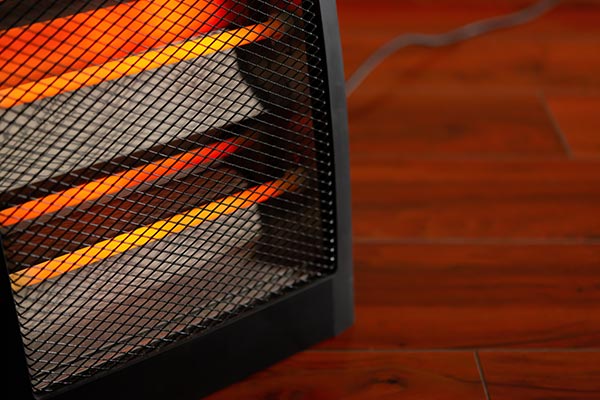
Fireplaces, wood stoves, and space heaters can be a cozy and economical way to heat your home in winter, but they also present a significant fire risk.
To stay safe, ensure you take the following precautions:
Fireplace/Wood Stove
- Never leave a fire in your fireplace or wood stove if you are not home. When putting the fire out, keep an eye on it to ensure it doesn't spark back up.
- You should only burn seasoned, dry wood in a fireplace and wood-burning stove. Other materials such as paper, cardboard, and glossy materials could lead to pops and sparks.
- Use a fire screen. They are meant to prevent embers from popping out of the fire and onto your carpet. If you have glass doors, keep them open to allow airflow, but keep the screen shut.
- Don’t leave children or pets unattended in areas with fire. They can be curious and potentially get hurt or cause fire damage.
- Always use fire-safe tools to rearrange logs or coals. Wrought iron pokers tend to work best.
- You want to keep your hair and clothes away from the fire when you're starting a fire in your fireplace. Having a Christmas tree near the fire might sound cozy, but it can be hazardous if you don't take the proper precautions. Keep your tree away from the fire, and don't knock it over when adding logs.
Chimney
Inspect and clean your chimney every year to prevent a buildup of debris that could cause a fire. It's best to do this in late summer or fall before you use your fireplace or wood stove for heat. To further protect against fire, install a chimney cap to keep birds and other animals from nesting in the chimney.
Space Heaters
Portable space heaters can heat cold or drafty rooms in your house, but they pose a significant fire risk, according to the CPSC. Space heaters account for 43% of home heating fires and 85% of associated deaths.
- Space heaters should always plug directly into the wall without using an extension cord or power strip. Check the cord often for signs of melting or burning. If the outlet is warm or hot to the touch, discontinue use and call an electrician.
- Never run your space heater while sleeping or away from home. It is best to preheat your space before sleeping and have the heater off at night. However, a heater with a thermostat or auto-shutoff may be a safer option.
Keep anything combustible at least 3 feet away from your fireplace, wood stove, or space heater. This includes items like fabrics, paper, and even hair.
Plugs, Outlets, and Surge Protectors
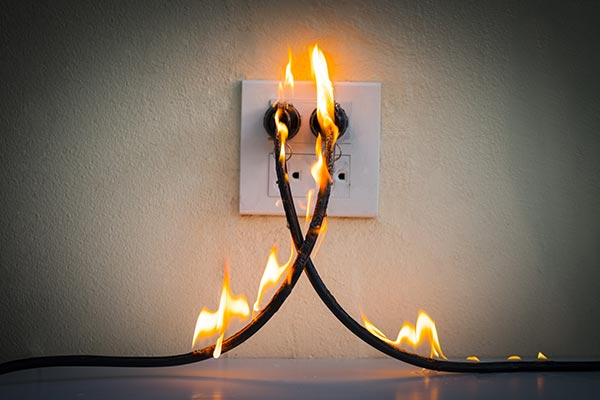
Check out the tips below.
- Pay attention to your outlets. If they suddenly stop working or feel warm to the touch, this could be an early sign of malfunction. If smoke or sounds (buzzing, popping) come from the outlet, turn off the power to that outlet immediately. Any of these signs indicates that the outlet isn't working correctly and can cause a fire. Call an electrician right away!
- Check your plugs to ensure they are in all the way and held tightly. Loose outlets or plugs could cause sparks and generate fire. If the outlet is loose, it likely needs to be replaced.
- Don’t run cords under the carpet or furniture. The power cords tend to have heat, so being under the carpet can be a fire risk.
- Examine your electrical outlets' wiring for fraying or damage. If you see any damage, call an electrician. Be on the lookout for signs that an item needs to be replaced immediately, such as frayed wires, surge marks in cables, or damaged cords. If you see any exposed wires, unplug the electronics and replace them immediately.
- Make sure you're using only what your circuits can handle. Call an electrician if you notice that your circuit breakers are constantly tripping or your lights are dimming when you use multiple outlets at once.
- Lamps and light fixtures are other potential sources of house fires. Ensure that the bulbs installed in every light and lamp in your house are within the manufacturer's wattage.
- Power strips and surge protectors need to be used with caution. Be sure not to overload either one because they could overheat or spark. It is also essential not to use them for heavy appliances like refrigerators and vacuum cleaners as this can cause a surge and be unsafe.
Candles & Nighttime Routines
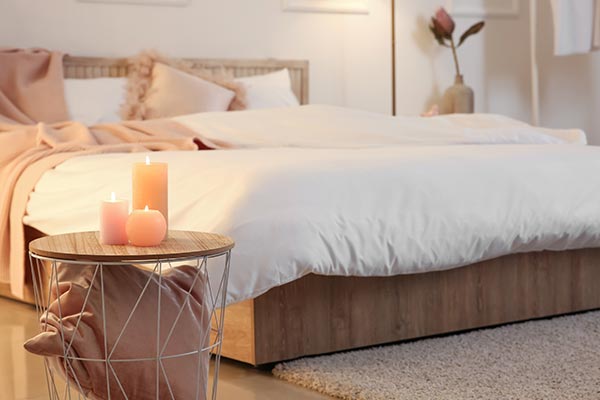
Bedroom and living room fires are responsible for 73 percent of house fire fatalities. These fires may be caused by people falling asleep while smoking or electrical problems, such as faulty wiring or malfunctioning electric blankets.
Usually, bedrooms and living rooms are full of fabrics, like bedding, clothing, and drapes, which can become fire hazards if they come in contact with electronic devices, appliances, or heat sources.
Read these tips below to help prevent fires at night.
- Be cautious when burning candles at night. The cozy feeling of the soft candle glow can make one fall asleep. If burning candles, ensure flammable items are far away from the candle (clothing, blankets). The best bet is to blow the candle out before going to sleep.
- When burning candles, keep them out of reach of pets and children. They should be higher to prevent fires if they can easily be tipped over.
- When finished using electronics such as laptops and cell phones, they should be placed on a hard surface such as a dresser or nightstand. These items heat up when lying on a soft surface like a bed or carpet.
- Like using a space heater, electric blankets should be turned off when sleeping. Extended use could cause the blanket to overheat.
- Don’t smoke in bed! Blankets and carpets can easily catch fire if a lit cigarette falls.
The Laundry Room
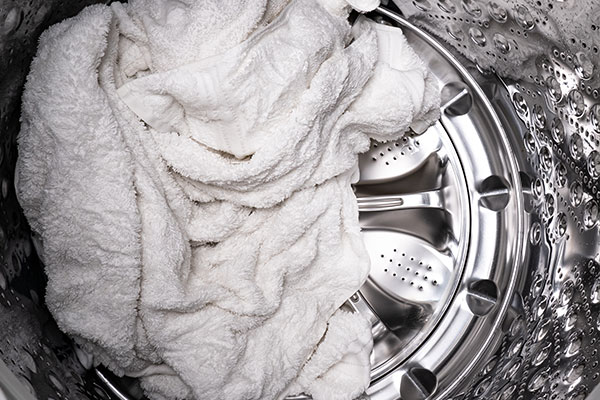
Natural Gas, Furnace, and Water Heater
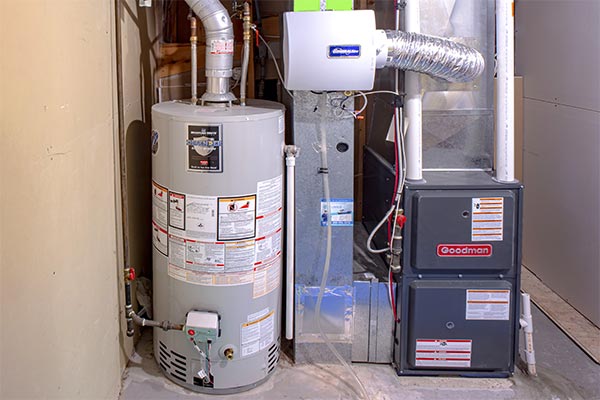
If you smell natural gas, get your family out immediately and call 911.
- Clutter in your home can increase the risk of fires starting and spreading. By reducing clutter, you can reduce the risk of fire and potentially increase the chances of saving your home in the event of a fire. Did you know that newspapers can self-combust? If you save them, keep them in a warm damp area to avoid combustion.
- Keep the area around your furnace and water heater free of debris and combustible materials.
- You must also clean the area around your furnace by vacuuming dirt, dust, and debris and keeping the site free of clutter. Often, these items are hidden away (out of sight, out of mind) but still need to be cleaned and inspected regularly to prevent leaks and fires.
Garages and Outside

Check out our tips for preventing fires outside the home.
- When grilling, ensure the grill is not too close to your home or any flammable objects. Ideally, you should be grilling at least 10 feet away. Never leave the grill unattended when cooking, and clean it regularly.
- Clean out firepits regularly to avoid the buildup of ashes and debris. Also, it's important to keep debris away from the outside of your home since things like firewood, leaves, pine needles, trees, and shrubs can easily catch fire from stray ashes or sparks. If you have a propane tank, remove dead trees or brush surrounding the tank as a preventative as well.
- Store flammable liquids like gas and kerosene in tightly sealed containers away from heat sources. Be sure to store combustible materials in their original containers, like paint and gasoline. Keep paint containers upside down, so the paint creates a seal. If a gasoline container develops a crack or leak, transfer its contents into a new container made of fire-resistant material.
- Did you know that potting soil is a fire risk? Fertilizers and some potting soil brands contain flammable materials that can combust under heat or after someone ashes a cigarette. It is best to store your gardening supplies in a cool, dry area.
Smoke Alarms & Carbon Monoxide Detectors
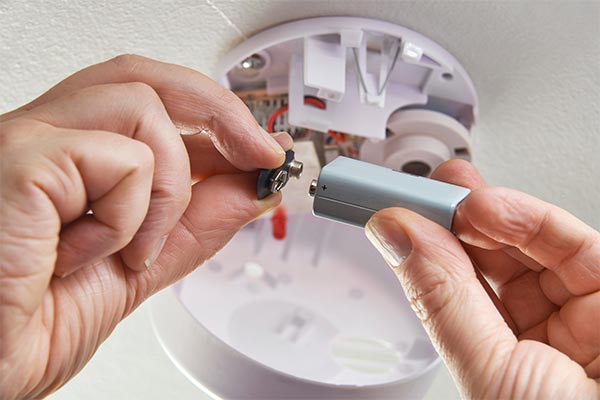
Read on for safety tips regarding your smoke alarms.
- Depending on your home, it is recommended to have a smoke detector installed in each sleeping area, outside that area, as well as in the kitchen (at least 10 feet away from appliances). If possible, try to have them all wired together, so they all go off simultaneously.
- Smoke detectors should be replaced every ten years and tested monthly. When testing, have someone in your home go to various rooms and ensure they can hear it. (it won’t help if you can’t hear it). Additionally, the batteries should be replaced every six months (around daylight savings time) to keep them working. That annoying little chirp is to let you know the batteries are failing, so don’t ignore it!
- Keep the alarms clean and free of cobwebs, dirt, and dust. Otherwise, they could go off when there isn’t a fire.
- Ensure you have a carbon monoxide detector within your home. While not as damaging as a fire, the risks are too great without one.
Commercial Sprinklers/Fire Ladder
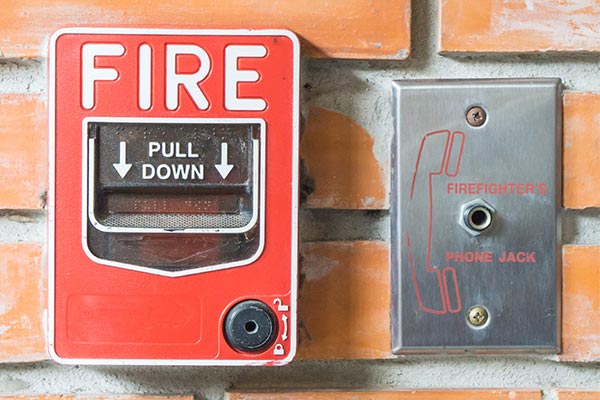
While we’re all used to seeing sprinklers in commercial buildings, it’s not as common to see them in homes. With sprinkler systems, it’s possible the fire could be out before the fire department even arrives. If you have a multiple-story building, having at least two fire ladders on the upper floors (kept in separate areas just in case one is inaccessible due to fire) is a wise idea.
Fire drills should be conducted regularly, both during the day and at night, to ensure that employees are familiar with the different evacuation routes from the building. The fire safety plan should be reviewed and practiced at least twice a year. During this time, you will be sure all alarms are working correctly; if not, you can get them serviced.
Fire Extinguishers
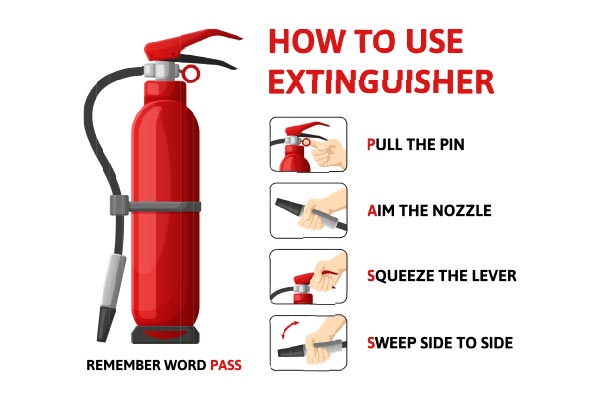
Fire extinguishers are only effective if used correctly and are the right size for the fire. They are best for small, localized fires. A multi-purpose fire extinguisher is the best option for a home. It should be large enough to put out a small fire but not so heavy that it is difficult to handle.
The NFPA recommends having a fire extinguisher on every level of your house(including the basement and garage) and an extra one in the kitchen near fire sources. Additionally, you will need to know what type of fire extinguisher is required for every kind of fire and how to use them. Read on to learn more.
Classes of Fire
Class A: Ordinary combustibles such as wood, cloth, and paper.
Class B: Flammable liquids such as gasoline, kerosene, oil, and oil-based paint.
Class C: Energized electrical equipment such as a TV, computer, stereo, etc.
Class D: Combustible metals such as magnesium.
Using a Fire Extinguisher
You must know how to use your fire extinguishers. Read the directions and become familiar with how they operate so that you can use them quickly and efficiently in the event of a fire. It is also recommended to check them annually to ensure they haven’t expired.
If you are unsure of how to use a fire extinguisher, call your local fire department, they can help. Most fire extinguishers operate the same fundamental way, though there may be some slight variations depending on the model.
Stand six to eight feet from the fire and remember to
PASS.
Pull the pin at the top to break the seal.
Aim the extinguisher low, pointing the nozzle at the base of the fire. Do not aim at the flames themselves.
Squeeze the handle to release the extinguishing agent.
Sweep the extinguisher from side to side, aiming at the base of the fire until it appears to be out.
What to Do During a Fire
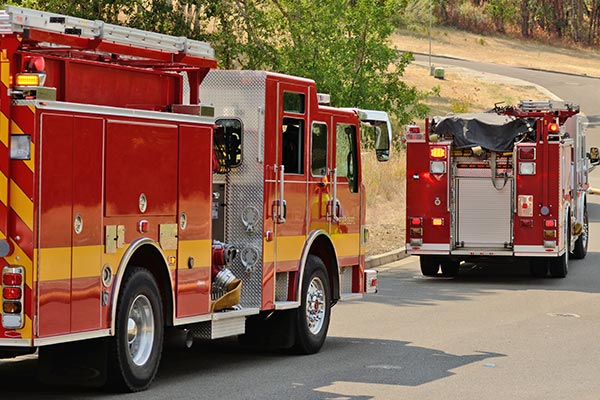
When a fire occurs, it is absolutely terrifying. You first worry about your family (including pets) and, eventually, your belongings and home.
Follow these tips in the event of a fire in your home.
- Remember your exit strategy. Stay low to the ground to reduce smoke inhalation, and test doorknobs for heat. When exiting a room, try to close the door behind you to allow more time to get out.
- Once you are out, stay out. Then, call 911.
- If you are unable to get out, try to seal yourself in using clothing to seal off doorways and cover vents. A good idea is to cover your nose and mouth with a towel or something similar to help filter smoke from the air you breathe. Open the window and try to call for help, or call 911 if you have a cell phone.
- Fire-resistant blankets may be good to have that are easily accessible in the event of a fire during the night. These will help protect the body from flames and hot air, allowing more time to get out.
- After the fire has been put out, call Rock Emergency for fire and smoke remediation services. There may be leftover water and damaged materials, but we are here 24-7 to help you get your home back in order.
If you or someone you know has recently had a House Fire, call our Rock Emergency professionals at (585) 413-1566. Or click the button below to send us a message!
Share this Post
